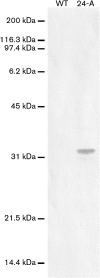Insights into the function of Mycoplasma pneumoniae protein P30 from orthologous gene replacement
- PMID: 21778204
- PMCID: PMC3353390
- DOI: 10.1099/mic.0.052464-0
Insights into the function of Mycoplasma pneumoniae protein P30 from orthologous gene replacement
Abstract
The attachment organelles of bacterial species belonging to the Mycoplasma pneumoniae phylogenetic cluster are required for host cytadherence, gliding motility and virulence. Despite being closely related, these bacteria possess distinct cellular morphologies and gliding characteristics. The molecular mechanisms for most attachment organelle phenotypes, including shape and ability to power motility, are obscure. The attachment organelle-associated P30 protein of M. pneumoniae is implicated in both adherence and motility, with mutations negatively impacting cell morphology, adherence, gliding and virulence. To test whether the P30 alleles of different mycoplasma species confer species-specific attachment organelle properties, we created an M. pneumoniae strain in which the Mycoplasma genitalium P30 orthologue, P32, was substituted for the native P30. Selected clones were visualized by scanning electron microscopy to assess morphology and by indirect immunofluorescence microscopy to localize P32. Cytadherence ability and gliding motility were assessed by haemadsorption assay and phase-contrast microcinematography, respectively. Cell and attachment organelle morphologies were indistinguishable from wild-type M. pneumoniae as well as M. pneumoniae II-3 expressing a C-terminally 6×His-tagged P30 construct. P32 was localized to the tip of the attachment organelle of transformant cells. Although a specific role for P30 in species-specific phenotypes was not identified, this first test of orthologous gene replacement in different mycoplasma species demonstrates that the differences in the M. pneumoniae and M. genitalium proteins contribute little if anything to the different attachment organelle phenotypes between these species.
Figures






Similar articles
-
P65 truncation impacts P30 dynamics during Mycoplasma pneumoniae gliding.J Bacteriol. 2012 Jun;194(11):3000-7. doi: 10.1128/JB.00091-12. Epub 2012 Apr 27. J Bacteriol. 2012. PMID: 22544269 Free PMC article.
-
Domain analysis of protein P30 in Mycoplasma pneumoniae cytadherence and gliding motility.J Bacteriol. 2011 Apr;193(7):1726-33. doi: 10.1128/JB.01228-10. Epub 2011 Jan 21. J Bacteriol. 2011. PMID: 21257768 Free PMC article.
-
Processing is required for a fully functional protein P30 in Mycoplasma pneumoniae gliding and cytadherence.J Bacteriol. 2011 Oct;193(20):5841-6. doi: 10.1128/JB.00104-11. Epub 2011 Aug 5. J Bacteriol. 2011. PMID: 21821772 Free PMC article.
-
Structure, function, and assembly of the terminal organelle of Mycoplasma pneumoniae.FEMS Microbiol Lett. 2001 Apr 20;198(1):1-7. doi: 10.1111/j.1574-6968.2001.tb10610.x. FEMS Microbiol Lett. 2001. PMID: 11325545 Review.
-
Mycoplasma pneumoniae cytadherence: unravelling the tie that binds.Mol Microbiol. 1996 Apr;20(2):247-53. doi: 10.1111/j.1365-2958.1996.tb02613.x. Mol Microbiol. 1996. PMID: 8733224 Review.
Cited by
-
Chinese advances in understanding and managing genitourinary tract infections caused by Mycoplasma genitalium, Mycoplasma hominis, and Ureaplasma urealyticum.Arch Microbiol. 2024 Nov 28;207(1):5. doi: 10.1007/s00203-024-04204-z. Arch Microbiol. 2024. PMID: 39607610 Review.
-
Pathogenicity and virulence of Mycoplasma genitalium: Unraveling Ariadne's Thread.Virulence. 2022 Dec;13(1):1161-1183. doi: 10.1080/21505594.2022.2095741. Virulence. 2022. PMID: 35791283 Free PMC article. Review.
-
Mycoplasma genitalium Biofilms Contain Poly-GlcNAc and Contribute to Antibiotic Resistance.Front Microbiol. 2020 Oct 27;11:585524. doi: 10.3389/fmicb.2020.585524. eCollection 2020. Front Microbiol. 2020. PMID: 33193233 Free PMC article.
-
Mycoplasma pneumoniae, an underutilized model for bacterial cell biology.J Bacteriol. 2014 Nov;196(21):3675-82. doi: 10.1128/JB.01865-14. Epub 2014 Aug 25. J Bacteriol. 2014. PMID: 25157081 Free PMC article. Review.
-
Integrated Information and Prospects for Gliding Mechanism of the Pathogenic Bacterium Mycoplasma pneumoniae.Front Microbiol. 2016 Jun 28;7:960. doi: 10.3389/fmicb.2016.00960. eCollection 2016. Front Microbiol. 2016. PMID: 27446003 Free PMC article.
References
-
- Balish M. F., Krause D. C. (2005). Mycoplasma attachment organelle and cell division. In Mycoplasmas: Molecular Biology, Pathogenicity, and Strategies for Control, pp. 189–237. Edited by Blanchard A., Browning G. Norwich: Horizon Bioscience.
Publication types
MeSH terms
Substances
Grants and funding
LinkOut - more resources
Full Text Sources
Research Materials

